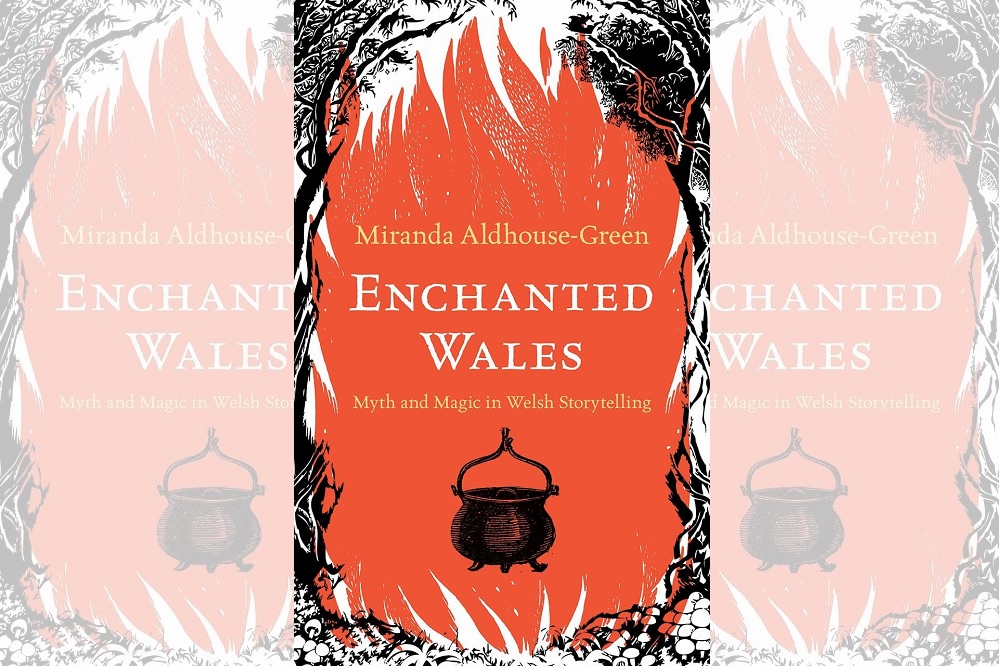Review: Enchanted Wales by Miranda Aldhouse-Green

Myfanwy Alexander
You wait a long time for a book on Welsh folklore, then two come along at once. Whilst we are still disgesting Delyth Badder and Mark Norman’s glorious book on Welsh Ghosts, Miranda Aldhouse-Green, Professor Emeritus at Cardiff University offers us this new, syncretic work, combining familiar tales with the deep insights of archaeologist.
It’s an unusual book, ambitious in its scope yet always accessible, blending narrative with more esoteric learning and beautifully illustrated by Jacob Stead whose black and white linocuts reminded me of the woodcuts found in Puffin books of myths and legends half a century ago.
Resonances
Aldhouse-Green has set herself a challenge: she has, within a slim volume, to both retell the stories of the Mabinogion and comment upon them.
She moves through the Branches of the Mabinogion faster than a falling squirrel, and it would be possible to enjoy this book without any prior knowledge of the corpus of Welsh stories. Her style is, of necessity, quite brisk: this is a work of exposition rather than a leisurely journey through linguistic glories.
The pace is at times rather break-neck, leaving the reader with brief but vivid glimpses of the characters, as if speed-dating Pwyll, Math and Gwydion. However, even in the early part of the book, Aldhouse-Green pauses, via boxed sections, to explore symbolic resonances, placing the characters of these familiar tales in context of Celtic beliefs.
This ingenious structure, which allows the reader to explore cosmographical byways without any loss of pace in the main narrative, is a notable strength of the book: we can chose to follow the story of Lleu and Blodeuwedd to its conclusion before returning to the exegesis on his possibly identity as a god of light.
Mythology
Aldhouse-Green is scrupulously honest about her sources. The fact is that we know little about the beliefs of Celtic peoples two thousand years ago, as traces of a verbal culture will axiomatically vanish quickly.
Add to that the tendency of Greeks and Romans to describe the lives of ‘barbarians’ in stock narratives using interchangable tropes and it is inevitable that our knowledge of the religion of our pre-Christian ancestors is sketchy.
This is where Aldhouse-Green plays her trump card. By adding her knowledge of archaeology to the themes emerging from the retold tales, it is possible to discern the significance of images, motifs and ideas.
She is also very familiar with the mythology of Ireland and draws significant and intriguing comparisons between the tales told on both sides of the Irish Sea.
Influences
Indeed, I would suggest that there is, perhaps, an over-reliance on Irish stories in this book.
Watching the sun set on Ynys Enlli, one is reminded how, to our ancestors, the sea was a nexus rather than a barrier and, of course, Irish raiders were a significant force in Wales for hundreds of years but for a scholar sitting, let us say, at his desk in Builth, noting down the tales in the book which would remain for years at Hergest Court, the neigbours to the east would surely also have some significant influence?
To give an example of this, the character of Gofannon, is both uncle to Gwydion in the Mabinogion stories and widely regarded as the smith god of the Celts, and the story of Wayland the Smith, common throughout Eastern and Central Europe had been brought to England long before the manuscript versions of the corpus of Welsh tales were created.
Might some symbiosis have taken place over Offa’s Dyke as well as across the Irish Sea? Aldhouse-Green readily admits a possible Virgilian influence, but seems curiously incurious about the Angles.
Christianity
There is another curious omission in this sifting and exploring of motifs; the iconography of Christianity.
At times, this seems almost glaring: when discussing shared ritual drinking vessels, one might expect more than a nod to the eucharistic chalice or the Grail but to me, the failure to include any analysis of the stories around Welsh Saints, whose ‘patterned lives’ were given a practical typology by Henken in 1997, reduces opportunities to explore co-existings narratives which share so many tropes.
This is, however, not unknown in the study of folklore, where untold hours are spent discussing a single sheila- na-gig whilst plentiful images of decapitated St Winefride are overlooked.
Enjoyable
However, the book does provide a stimulating and accessible overview of the motifs which have shaped these familiar stories. The analysis of the use of colour and the significance of the cauldron resonate deeply, giving a fresh understanding to both the tales and their context.
It is a sign of success in a book of this type that it should be both enjoyable and spark debate and if I may take issue with Aldhouse-Green’s conjectures in places, I salute her for the bold way in which she challenges us to blow the dust off our greatest literary treasures and read them afresh.
Enchanted Wales by Miranda Aldhouse-Green is published by Calon. It is available from all good bookshops.
Support our Nation today
For the price of a cup of coffee a month you can help us create an independent, not-for-profit, national news service for the people of Wales, by the people of Wales.






